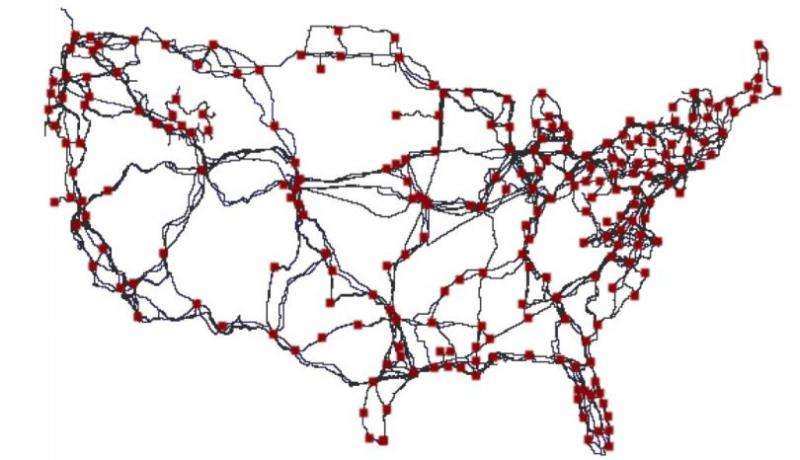September 17, 2015 weblog
Map brings needed attention to underpinning of Internet

Four researchers have completed their study, "InterTubes: A Study of the US Long-haul Fiber-optic Infrastructure." The authors of this paper are drawing attention to the physical side of the wired Internet and its future: Attention must be paid. They said, "it is either taken for granted or implicitly assumed that the physical infrastructure of tomorrow's Internet will have the capacity, performance, and resilience required to develop and support ever more bandwidth-hungry, delay-intolerant, or QoS-sensitive services and applications."
What is the reality? One part of that answer is that "very little is known about today's physical Internet where individual components such as cell towers, routers or switches, and fiber-optic cables are concrete entities with well-defined geographic locations," said the authors. "This general lack of a basic understanding of the physical Internet is exemplified by the much-ridiculed metaphor used in 2006 by the late U.S. Senator Ted Stevens (R-Alaska) who referred to the Internet as "a series of tubes."
The authors said they were exclusively interested in the long-haul fiber-optic portion of the wired Internet in the US.
Their research represents a contribution to understanding what the physical Internet infrastructure actually looks like.
They relied on publicly available fiber maps provided by many tier-1 ISPs and major cable providers.
Some of those maps included precise geographic locations of all the long-haul routes deployed or used by the corresponding networks, but, they said, there were other maps that lacked detailed information. They turned to use of previously neglected or under-utilized data sources in the form of public records from federal, state or municipal agencies or documentation generated by commercial entities, such as fiber map providers, utility rights-of-way (ROW) information, environmental impact statements and fiber sharing arrangements by the different states' DOTs.
When combined, they said, the information available in these records was often enough to reverse-engineer the geography of the actual longhaul fiber routes of those networks that have decided against publishing their fiber maps.
Commenting on their work, Tom Simonite in MIT Technology Review provided perspective on the usefulness of the map, which took around four years to produce.
The map shows the paths taken by the long-distance fiber-optic cables carrying Internet data across the continental U.S. The map has red squares showing where different cables connect, mostly in major population centers.
According to MIT Technology Review, Prof. Paul Barford, a co-author of this study, said the exact routes of those cables, which belong to major telecommunications companies such as AT&T and Level 3, have not been previously publicly viewable, despite the fact that they are effectively critical public infrastructure.
Simonite reported that the Department of Homeland Security is making the map and data behind it available through a project called Predict, which offers data relevant to Internet security to government, private and public researchers.
More information: InterTubes: A Study of the US Long-haul Fiber-optic Infrastructure, pages.cs.wisc.edu/~pb/tubes_final.pdf
© 2015 Tech Xplore



















